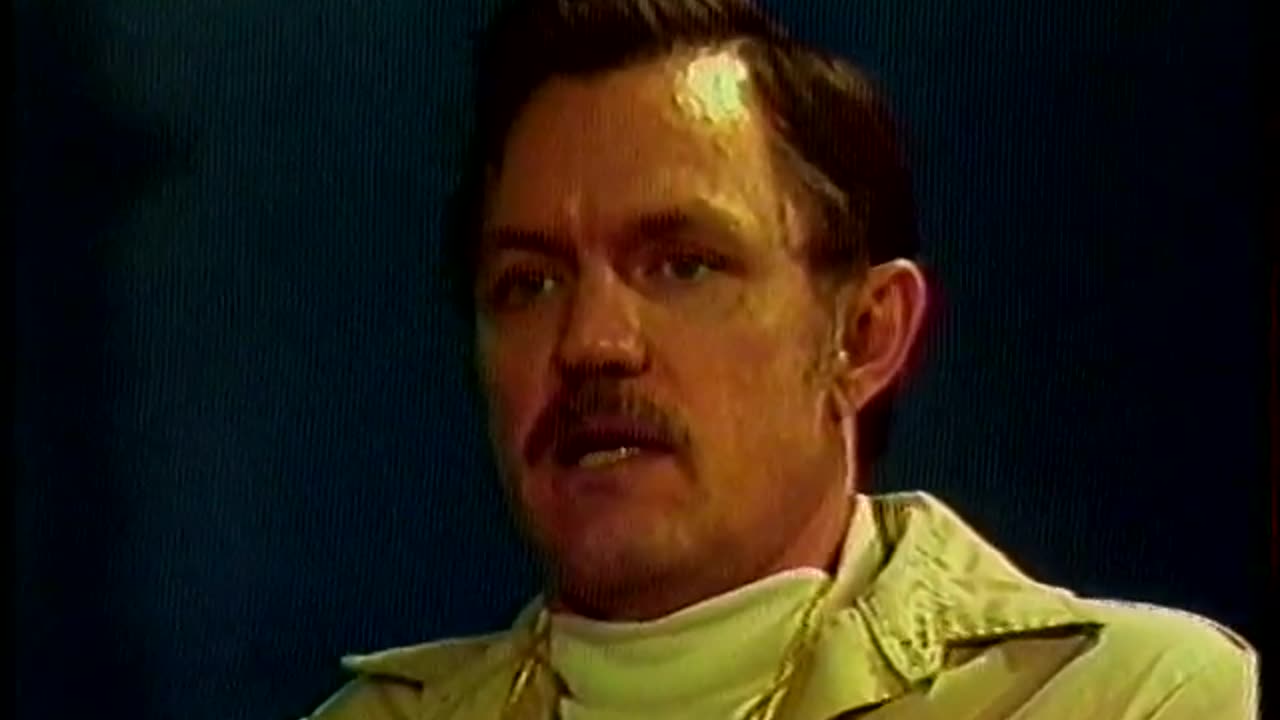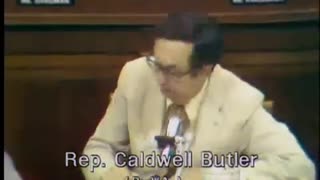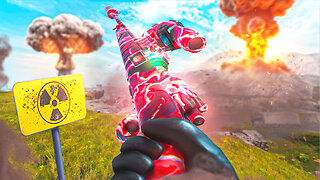Premium Only Content

Journey of Reflection: A CIA Officer's Return to Vietnam (1985)
More CIA stories from John Stockwell: https://thememoryhole.substack.com/
Embark on an emotional odyssey with former CIA official John Stockwell as he returns to Vietnam alongside his Vietnamese wife and son. This poignant trip, months in the making, involved navigating bureaucratic hurdles for visas, evoking a complex tapestry of sentiments within John and his family, given his prior work in the country during the war's final stages.
In this gripping interview recorded in December 1985, John intimately narrates his observations of Vietnam's landscape, its resilient people, and the government's efforts toward post-war recovery. Delving into a wealth of articles and books chronicling Vietnam's contemporary state, John provides a profound analysis, shedding light on the government's multifaceted approaches to tackle the nation's vast challenges, both economic and political.
Amidst Vietnam's journey toward healing, John reveals a sobering reality: the nation remains embroiled in conflict, fending off a forceful Chinese invasion while engaging in military operations in Cambodia. Adding complexity to this landscape, the U.S. is quietly orchestrating a covert CIA operation against Vietnam.
This interview offers a rare glimpse into his profound encounters in the country, spanning from wartime endeavors to the present, capturing the enduring spirit of Vietnam amid ongoing struggles and aspirations for peace.
The communists renamed the city after Ho Chi Minh, former President of North Vietnam, although the name "Saigon" continued to be used by many residents and others.[91] Order was slowly restored, although the by-then-deserted U.S. Embassy was looted, along with many other businesses. Communications between the outside world and Saigon were cut. The Viet Cong machinery in South Vietnam was weakened, owing in part to the Phoenix Program, so the PAVN was responsible for maintaining order and General Trần Văn Trà, Dũng's administrative deputy, was placed in charge of the city.[70] The new authorities held a victory rally on 7 May.[92]
One objective of the Communist Party of Vietnam was to reduce the population of Saigon, which had become swollen with an influx of people during the war and was now overcrowded with high unemployment. "Re-education classes" for former soldiers in the ARVN indicated that in order to regain full standing in society they would need to move from the city and take up farming. Handouts of rice to the poor, while forthcoming, were tied to pledges to leave Saigon for the countryside. According to the Vietnamese government, within two years of the capture of the city one million people had left Saigon, and the state had a target of 500,000 further departures.[91]
Following the end of the war, according to official and non-official estimates, between 200,000 and 300,000 South Vietnamese were sent to re-education camps, where many endured torture, starvation, and disease while they were being forced to do hard labor.[93][94][95]
The evacuation
Whether the evacuation had been successful or not has been questioned following the end of the war. Operation Frequent Wind was generally assessed as an impressive achievement—Văn Tiến Dũng stated this in his memoirs and The New York Times described it as being carried out with "efficiency and bravery".[96] On the other hand, the airlift was also criticized for being too slow and hesitant, and it was inadequate in removing Vietnamese civilians and soldiers who were connected with the American presence.[citation needed]
The U.S. State Department estimated that the Vietnamese employees of the U.S. Embassy in South Vietnam, past and present, and their families totaled 90,000 people. In his testimony to Congress, Ambassador Martin asserted that 22,294 such people were evacuated by the end of April.[97] In 1977, National Review alleged that some 30,000 South Vietnamese had been systematically killed using a list of CIA informants left behind by the U.S. embassy.[98]
An iconic photograph of evacuees entering a CIA Air America helicopter on the roof of the apartment building at 22 Gia Long Street is frequently mischaracterized as showing an evacuation from the "U.S. Embassy" via a "military" helicopter.[99]
Commemoration
30 April is celebrated as a public holiday in Vietnam as Reunification Day (though the official reunification actually occurred on 2 July 1976) or Liberation Day (Ngày giải phóng). Along with International Workers' Day on 1 May, most people take the day off work and there are public celebrations.[100]
Among most overseas Vietnamese, the week of 30 April is referred to as "Black April" and it is also commemorated as a time of lamentation for the fall of Saigon and South Vietnam as a whole.[101]
In popular culture
Miss Saigon, A Better Tomorrow III: Love & Death in Saigon and The Deer Hunter including the scenery of the fall of Saigon.
Some video records during the fall of Saigon was featured in the seventh season of the Canadian made, internationally distributed documentary series Mayday, in the episode "Operation Babylift", which covered the C-5 plane crash prior to this event.
Liberate Saigon [vi] (Giải phóng Sài Gòn) is a 2005 Vietnamese film dramatizing the battle for the capture of Saigon.[102]
See also
flagVietnam portal
Indochina refugee crisis
Re-education camp (Vietnam)
John Riordan
Fall of Kabul (2021)
Fall of Phnom Penh
References
Ho Chi Minh Campaign (30 April 1975) (Vietnamese: Chiến dịch Hồ Chí Minh lịch sử (30/4/1975))
"Trận chiến bi hùng của Bộ đội xe tăng Trung đoàn 273: 9 xe bị bắn cháy ngay trước giờ toàn thắng". Archived from the original on 27 May 2022. Retrieved 26 March 2022.
Lam, Andrew (29 April 2015). "Op-Ed: Is it Liberation Day or Defeat Day in Saigon?". Los Angeles Times. Archived from the original on 16 February 2016. Retrieved 13 February 2016.
Austin, Lewis C. (1 October 1976). "Giai Phong! The Fall and Liberation of Saigon, by Tiziano Terzani". Foreign Affairs. Archived from the original on 16 February 2016. Retrieved 13 February 2016.
Long, Ngo Vinh (1993). "Post-Paris Agreement Struggles and the Fall of Saigon". In Werner, Jayne Susan; Huynh, Luu Doan (eds.). The Vietnam War: Vietnamese and American Perspectives. M.E. Sharpe. p. 204. ISBN 9780765638632. Archived from the original on 30 April 2023. Retrieved 7 September 2019.; Thap, Nguyen Thi (2012). "Returning to my Home Village". In Dutton, George; Werner, Jayne; Whitmore, John K. (eds.). Sources of Vietnamese Tradition. Columbia University Press. pp. 547–53. ISBN 9780231511100. Archived from the original on 30 April 2023. Retrieved 7 September 2019.
Yoshida, Kenichi (23 April 2017). "Was it 'fall' or 'liberation' of Saigon?". The Nation Thailand. Archived from the original on 4 April 2023. Retrieved 23 April 2022.
"Chào mừng kỷ niệm 47 năm Ngày Giải phóng Miền Nam (30/4/1975 – 30/4/2022)" [Welcoming the 47th anniversary of the Liberation of the South (30/4/1975 – 30/4/2022)]. Online Newspaper of the Communist Party of Vietnam (in Vietnamese). Archived from the original on 23 April 2022. Retrieved 23 April 2022.
"Reliving the fall of Saigon with Vietnam vets and journalists". PBS NewsHour. 30 April 2015. Retrieved 2 May 2023.
Walsh, Kenneth T. (30 April 2015). "The U.S. and Vietnam: 40 Years After the Fall of Saigon". U.S. News & World Report. Archived from the original on 4 November 2018. Retrieved 3 November 2018..
Multiple sources:
"Last American Ground Combat Unit Is Deactivated in South Vietnam". The New York Times. 12 August 1972. Archived from the original on 5 May 2021. Retrieved 9 April 2020.
John J. Valdez. "The Last to Leave". fallofsaigon.org. Archived from the original on 9 October 2015. Retrieved 12 October 2015. "I think we got all the Americans out who wanted to leave. Some of them elected to stay there, mostly reporters." (originally published in the May 1975 issue of Leatherneck Magazine)
Krich, Claudia (3 May 2015). "Eyewitness to the 'fall' of Vietnam: It was not a bloodbath". The Davis Enterprise. p. B5. Archived from the original on 28 September 2015. Retrieved 12 October 2015. (The article describes the experiences of three American women who stayed in Saigon)
Laurie, Jim. "Vietnam 2015 – 40 years on". Archived from the original on 17 November 2015. (Article by an American journalist who chose not to be evacuated)
"Americans who stayed on may be source of sightings". New Straits Times. 3 August 1991. Archived from the original on 17 November 2015. Retrieved 13 October 2015. (Article asserting that about 70 Americans stayed behind and containing details of some individual cases)
"The Last Days in Vietnam". Movie review. Archived from the original on 18 November 2015. Retrieved 13 October 2015. "This is a story about a few brave, good people who stayed behind in order to not leave anyone behind." (mentions NBC correspondents Jim Laurie and Neil Davis who stayed after the evacuation)
Dunham, Maj. George R.; Quinlan, Col. David A. (1990). U.S. Marines in Vietnam: The Bitter End, 1973–1975 (Marine Corps Vietnam Operational Histories Series) (PDF). Washington DC: History & Museums Division; Headquarters, U.S. Marine Corps. ISBN 978-0-16-026455-9. Archived (PDF) from the original on 10 July 2021. Retrieved 3 May 2021.Public Domain This article incorporates text from this source, which is in the public domain.
Desbarats, Jacqueline. "Repression in the Socialist Republic of Vietnam: Executions and Population Relocation", from The Vietnam Debate (1990) by John Morton Moore.
Bharath, Deepa (29 April 2011). "O.C. Black April events commemorate fall of Saigon". Orange County Register. Archived from the original on 12 December 2013. Retrieved 18 January 2014.
Nguyen, Hien. "How Saigon became Ho Chi Minh City". VnExpress International. Archived from the original on 26 May 2022. Retrieved 23 April 2022.
"Black April". Los Angeles Times. Archived from the original on 21 December 2013. Retrieved 7 December 2013.
"Black April". UNAVSA Knowledge. Archived from the original on 10 December 2013. Retrieved 7 December 2013.
"April 30th 1975, betrayed and abandoned". vnafmamn.com. Archived from the original on 10 November 2013. Retrieved 7 December 2013.
Secretary of State. "Assembly Concurrent Resolution No. 220 Chapter 74 Relative to Black April Memorial Week". Legislative Counsel's Digest. California Legislative Information. Archived from the original on 12 December 2013. Retrieved 7 December 2013.
Kurhi, Eric (30 April 2013). "Black April ceremony honors Vietnam War soldiers in San Jose". San Jose Mercury News. Archived from the original on 11 December 2013. Retrieved 7 December 2013.
Bharath, Deepa (29 April 2011). "O.C. Black April events commemorate fall of Saigon". Orange County Register. Archived from the original on 12 December 2013. Retrieved 7 December 2013.
Bharath, Deepa (25 April 2008). "Black April events commemorate fall of Saigon". Orange County Register. Archived from the original on 18 May 2009. Retrieved 28 May 2009.
"Audio Slideshow: Black April". Los Angeles Times. Archived from the original on 4 May 2009. Retrieved 28 May 2009.
Trần, Mỹ-Thuận (30 April 2009). "Orange County's Vietnamese immigrants reflect on historic moment". Los Angeles Times. Archived from the original on 3 May 2009. Retrieved 28 May 2009.
Dzũng, Đỗ (30 April 2009). "Tưởng niệm Tháng Tư Đen ở Quận Cam". Báo Người Việt. Archived from the original on 2 May 2009. Retrieved 28 May 2009.
Todd 1990, p. 433.
Tanner 2000, p. 303.
Dawson 1977, p. xiii.
Snepp 1977, p. 280.
Todd 1990, p. 248.
Todd 1990, p. 249.
"On This Day | 21 April | 1975: Vietnam's President Thieu resigns". BBC Home. 21 April 2008. Archived from the original on 22 November 2010.
Dawson 1977, p. xv.
Willbanks 2004, p. 257.
Weinraub, Bernard (1 April 1975). "Attack on Saigon Feared; Danang Refugee Sealift is Halted by Rocket Fire". The New York Times. p. 1.
Pike 1970.
Tanner 2000, p. 312.
Dawson 1977, p. xiv.
Butterfield, Fox (2 April 1975). "Many Americans Quit Vietnam; U.S. Denies Evacuation Orders". The New York Times. p. 1. Archived from the original on 16 August 2021. Retrieved 16 August 2021.
Snepp 1977, p. 312.
Snepp 1977, p. 304.
Kissinger 2003, pp. 540–41.
Snepp 1977, p. 330.
Snepp 1977, p. 303.
Snepp 1977, p. 352.
Brown 1976, p. 318.
Todd 1990, p. 311.
Lipman, Jana K. (2014). "A Refugee Camp in America: Fort Chaffee and Vietnamese and Cuban Refugees, 1975–1982". Journal of American Ethnic History. 33 (2): 58. doi:10.5406/jamerethnhist.33.2.0057. JSTOR 10.5406/jamerethnhist.33.2.0057. Archived from the original on 25 January 2021. Retrieved 23 January 2021. "Anticipating political and presumably personal freedom within the United States, numerous refugees found themselves unexpectedly waiting days, and at times weeks and months, in military compounds.... The 1975 Vietnamese refugees were disproportionately former active members of the South Viet-namese military and government"
Snepp 1977, p. 287.
Snepp 1977, p. 316.
Snepp 1977, p. 289.
Snepp 1977, p. 319.
Todd 1990, p. 296.
Todd 1990, p. 298.
"Saigon Hears the Fighting at Its Edge". The New York Times. 28 April 1975. Archived from the original on 6 March 2016. Retrieved 25 September 2016.
Vietnam Newport Bridge on YouTube
Willbanks 2004, p. 275.
Tobin, Thomas (1978). USAF Southeast Asia Monograph Series Volume IV Monograph 6: Last Flight from Saigon. U.S. Government Printing Office. ISBN 9781410205711.Public Domain This article incorporates text from this source, which is in the public domain.
Todd 1990, p. 347.
Smith 1975.
Tanner 2000, p. 313.
Todd 1990, p. 353.
Schudel, Matt (31 March 2014). "Thomas Polgar, CIA official during the fall of Saigon, dies". The Washington Post. Archived from the original on 9 March 2016. Retrieved 24 November 2016.
Esper, George, "Copters Ending Vietnam Era", The Washington Star, Washington, D.C., Tuesday 29 April 1975, p. A-1.
Todd 1990, p. 366.
Todd 1990, p. 367.
Snepp 1977, p. 478.
Tanner 2000, p. 314.
Todd 1990, p. 370.
Snepp 1977, p. 551.
Snepp 1977, p. 568.
Isaacs 1983, p. 393.
Moise 1988, p. 15.
Veith, George (2012). Black April The Fall of South Vietnam 1973–75. Encounter Books. pp. 488–489. ISBN 9781594035722.
Associated Press, "Minh Surrenders, Vietcong In Saigon".
Oliver, Myrna (8 August 2001). "Duong Van Minh; Last President of S. Vietnam". Los Angeles Times. Archived from the original on 4 October 2012. Retrieved 11 October 2009.
Terzani, Tiziano (1976). Giai Phong! The Fall and Liberation of Saigon. Angus & Robertson (U.K.) Ltd. pp. 92–96. ISBN 0207957126.
"Reunion of the Veterans organization of Tank Amour force in the South Vietnam". Dinh Độc Lập official website. 28 April 2020. Archived from the original on 15 January 2022. Retrieved 14 January 2022.
Ryan, Jane (8 September 2015). "Revered war cameraman Neil Davis remembered". ABC News. Archived from the original on 14 January 2022. Retrieved 14 January 2022.
"Pride and obscurity: the historic crew of Vietnam's 'Tank 390'". Agence France-Presse. 24 April 2015. Archived from the original on 30 April 2023. Retrieved 14 January 2022.
Nguyen Ha Minh (Reuters) (29 April 2015). "Vietnam's war heroes get star treatment 40 years after fall of Saigon". The Sydney Morning Herald reposted. Archived from the original on 14 January 2022. Retrieved 14 January 2022. {{cite web}}: |author= has generic name (help)
Prime Minister of Vietnam (1 October 2012), "Decision No. 1426/QD-TTg on recognization of national precious objects", luatminhkhue.vn, Hanoi, archived from the original on 18 July 2020, retrieved 14 January 2022
Khanh Nguyen-Doan Hiep (27 April 2010), "Famous person with simple life", People's Army Newspaper, Hanoi, archived from the original on 14 January 2022, retrieved 14 January 2022
Mai Huong (27 June 2012), "2nd Corps headed to Sai Gon from Southeast direction", Sai Gon Giai Phong Online (in Vietnamese), Ho Chi Minh City, archived from the original on 14 January 2022, retrieved 14 January 2022
Leong, Ernest (31 October 2009), "Vietnam Tries to Create New Image 30 Years After End of War", Voice of America, archived from the original on 15 January 2022, retrieved 14 January 2022
Bui, Tin (1999). Following Ho Chi Minh: The Memoirs of a North Vietnamese Colonel. University of Hawaii Press. pp. 84–86. ISBN 9780824822330. Archived from the original on 30 April 2023. Retrieved 21 March 2023.
"Chứng nhân phương Tây duy nhất trong Dinh Độc Lập ngày 30-4-1975". Tuổi Trẻ (in Vietnamese). 28 April 2021. Archived from the original on 18 February 2022. Retrieved 14 January 2022.
Ellison, Richard (Series Producer) (2 February 1981). "Vietnam: A Television History; Interview with Bui Tin [2], 1981". WGBH Educational Foundation. Archived from the original on 14 January 2022. Retrieved 14 January 2022.
Butterfield, Fox (8 August 2001). "Duong Van Minh, 85, Saigon Plotter, Dies". The New York Times. Archived from the original on 27 November 2012. Retrieved 29 November 2012.
Ives, Mike (13 August 2013). "Bui Tin, Colonel Who Accepted South Vietnam's Surrender, Dies at 90". The New York Times. Archived from the original on 14 January 2022. Retrieved 15 January 2022.
People's Committee of Ca Mau Province (20 April 2015), "The full transcript of Republic of Vietnam's President declaration of surrender and the acceptance statement from respresentatives of Liberation Army of South Vietnam", Online portal of Ca Mau province (in Vietnamese), Ca Mau, archived from the original on 14 January 2022, retrieved 14 January 2022
Dawson 1977, p. 351.
Dawson 1977, p. xvi.
Porter, Gareth; Roberts, James (1 January 1988). Desbarats, Jacqueline; Jackson, Karl D. (eds.). "Creating a Bloodbath by Statistical Manipulation". Pacific Affairs. 61 (2): 303–10. doi:10.2307/2759306. JSTOR 2759306.
Metzner, Edward P. (2001). Reeducation in Postwar Vietnam: Personal Postscripts to Peace. Texas A&M University Press. p. xiii. ISBN 9781585441297. "250,000."
Sagan, Ginetta; Denney, Stephen (October–November 1982). "Re-education in Unliberated Vietnam: Loneliness, Suffering and Death". The Indochina Newsletter. Archived from the original on 14 September 2016. Retrieved 1 September 2016.
New York Times, "The Americans Depart"
Snepp 1977, p. 565.
Le Thi Anh, "The New Vietnam", National Review, 29 April 1977. "According to Frank Snepp, a CIA analyst who served in Saigon, the American Embassy was not able to destroy its top-secret files during the frantic evacuation, and among the information that fell into Communist hands was a list of 30,000 Vietnamese who had worked in the Phoenix Program, a U.S.-sponsored operation responsible for the elimination of thousands of Communist agents. A full report on the massacre of those 30,000 Phoenix cadres is said to have reached the desk of the French ambassador to Saigon by late 1975; he communicated it to Washington, where nothing was done with it."
Bradley, James (2015). The China mirage : the hidden history of American disaster in Asia. New York. p. 369. ISBN 978-0-316-19667-3. OCLC 870199580.
"Đông 'nghẹt thở', người dân cố nhích từng bước rời Hà Nội trước kỳ nghỉ lễ 30/4". Báo điện tử Tiền Phong (in Vietnamese). 28 April 2023. Retrieved 17 August 2023.
"Black April events commemorate fall of Saigon". The Orange County Register. Archived from the original on 18 May 2009. Retrieved 13 February 2016.
"Giai phóng Sai Gòn (2005)". IMDb. Archived from the original on 18 March 2022. Retrieved 28 April 2021.
Further reading
Adams, E. G. "The Beginning of the End". Archived from the original on 20 July 2011.
Brown, Weldon A. (1976). The Last Chopper: The Dénouement of the American Role in Vietnam, 1963–1975. Kennikat Press. ISBN 0-8046-9121-5.
Butler, David (1985). The Fall of Saigon. New York: Simon and Schuster. ISBN 0-671-46675-5.
Dawson, Alan (1977). 55 Days: The Fall of South Vietnam. Prentice-Hall. ISBN 0-13-314476-3.
Dunham, George R.; Quinlan, David A. (1990). U.S. Marines in Vietnam: The Bitter End, 1973–1975 (PDF). Washington DC: History and Museums Division, Headquarters, U.S. Marine Corps. ISBN 978-0-16-026455-9. Archived (PDF) from the original on 10 July 2021. Retrieved 3 May 2021.
Engelmann, Larry (1990). Tears before the Rain: An Oral History of the Fall of South Vietnam. Oxford University Press. ISBN 978-0-19-505386-9.
Isaacs, Arnold (1983). Without Honor: Defeat in Vietnam and Cambodia. The Johns Hopkins University Press. ISBN 0-8018-6107-1.
Kissinger, Henry (2003). Ending the Vietnam War: A History of America's Involvement in and Extrication from the Vietnam War. Simon & Schuster. ISBN 0-7432-1532-X.
Pike, Douglas (1970). "The Viet-Cong Strategy of Terror" (PDF). vietnam.ttu.edu. Archived from the original (PDF) on 20 July 2011. Retrieved 18 January 2007.
Smith, Homer D. (22 May 1975). "The Final Forty-Five Days in Vietnam" (PDF). vietnam.ttu.edu. Archived from the original (PDF) on 20 July 2011. Retrieved 16 January 2007.
Snepp, Frank (1977). Decent Interval: An Insider's Account of Saigon's Indecent End Told by the CIA's Chief Strategy Analyst in Vietnam. Random House. ISBN 0-394-40743-1.
Tanner, Stephen (2000). Epic Retreats: From 1776 to the Evacuation of Saigon. Sarpedon. ISBN 1-885119-57-7. (See especially p. 273 and on.)
Todd, Olivier (1990). Cruel April: The Fall of Saigon. W W Norton & Company. ISBN 0-393-02787-2. (originally published in 1987 in French)
Tucker, Spencer C., ed. (1998). Encyclopedia of the Vietnam War: A Political, Social, and Military History. Oxford University Press. ISBN 0-874-36983-5.
Văn Tiến Dũng (1977). Our Great Spring Victory: An Account of the Liberation of South Vietnam. Monthly Review Press. ISBN 0-85345-409-4.
Willbanks, James H. (2004). Abandoning Vietnam: How America Left and South Vietnam Lost Its War. University Press of Kansas. ISBN 978-0-7006-1331-1.
"The Americans Depart". The New York Times. 30 April 1975. p. 37. Archived from the original on 16 August 2021. Retrieved 16 August 2021.
Moise, Edwin E. (1988). "Nationalism and Communism in Vietnam". Journal of Third World Studies. University Press of Florida. 5 (2): 6–22. JSTOR 45193059.
CIA activities in Vietnam were operations conducted by the Central Intelligence Agency in Vietnam from the 1950s to the late 1960s, before and during the Vietnam War. After the 1954 Geneva Conference, North Vietnam was controlled by communist forces under Ho Chi Minh's leadership. South Vietnam, with the assistance of the U.S., was anti-communist. The economic and military aid supplied by the U.S. to South Vietnam continued until the 1970s. The CIA participated in both the political and military aspect of the wars in Indochina.[1] The CIA provided suggestions for political platforms, supported candidates, used agency resources to refute electoral fraud charges, manipulated the certification of election results by the South Vietnamese National Assembly, and instituted the Phoenix Program. It worked particularly closely with the ethnic minority Montagnards, Hmong, and Khmer.[2] There are 174 National Intelligence Estimates dealing with Vietnam, issued by the CIA after coordination with the US intelligence community.[3]
Vietnam 1945–1947
Through 1954, Vietnam was part of French Indochina, along with Laos and Cambodia. During the war, the Imperial Japanese Army occupied Vietnam and remained there until 1945, when the Axis powers were defeated. The Japanese were removed from Vietnam with the help of revolutionary leader Ho Chi Minh and his Vietminh forces.[4] Following the war, France began to reoccupy the Indochina region and reassert its former dominance. Much of this can be traced back to a desire to restore French glory and national pride after the humiliation the nation suffered during the course of World War II. The French also wished to reclaim the Indochina region to regain control over the vast rubber plantations across the country.
The people of Vietnam were completely against the return of the French. The Vietnamese experienced a lot of abuses by the French during their colonization in the mid 19th century. The people of North Vietnam rallied around their recently returned revolutionary leader Ho Chi Minh and looked to him to gain at long last, their independence.[5]
The French spent nine years (1946–54) attempting to regain control of Vietnam. France did not realize that the current Vietnamese were much stronger than those that they were familiar with. They greatly underestimated the strength and capability of the Vietnamese force. The Viet Minh, or Viet Cong as they came to be called, were not going to let the French take control of their region without a fight. The men of the Viet Cong were communists and did not want to surrender their beliefs to the French. Together with the North Vietnamese army, they would defend their land. The Vietnamese used military and political tactics to push and expel the French from their lands. North Vietnamese troops were prepared to fight the French to the bitter end in order to ensure victory and their freedom. The loss of thousands of French men made it easy for North Vietnam and the Viet Cong to win the war. France lost a lot of their supporters of the war after many of their men were killed. It was also beneficial to the North Vietnamese efforts when they began to receive outside assistance. The Soviet Union sent them military hardware that they used in combat against the French. After suffering a major defeat at the fortress of Dien Bien Phu on May 7, 1954, the French lost control of Viet Nam above latitude 17 degrees north; this became the Democratic Republic of Viet Nam. Soviet- and Chinese-made weapons and captured American ones given to the North Vietnamese army by China played a key role in the defeat of France.
Even before the CIA was formed, teams from the OSS, including one under Major Archimedes Patti, was in French Indochina, assessing the situation, and discussing alternatives with parties on all sides, including Ho Chi Minh.[6]
Vietnam 1950–1954
CIA officers moved to French Indochina in 1950 as a part of the legation of the United States in the city of Saigon. After their arrival, CIA involvement expanded to a new large base in Hanoi. The CIA's activities in Vietnam did not grow any further due to the French discouraging CIA activity (the French were still clinging to the idea that they could one day still dominate Vietnam and the U.S. was against this course of action).[7]
CIA involvement in Vietnam was discouraged by the French because it was found that the CIA would often bypass them to open channels to Vietnamese nationalists. CIA activity expanded when the Indochina region became three separate states, and grew exponentially during the French War in 1953 to 1954 when France was essentially forced to accept American assistance with unconventional warfare activities.[8]
Despite this resilience by the French, CIA intelligence perceived a deteriorating situation in Vietnam. A 1950 CIA intelligence report noted that the threat of Communism in Indochina was rising as rebel attacks on French outposts continued and highlighted the weaknesses of the French. An intelligence report on Indochinese military developments revealed how vulnerable the French military was, due to the fall of the French border holding at Dong Khe, as well as some attacks they had suffered in Tonkin. The report doubted France's ability to hold Indochina much longer if the Viet Minh continued to attack.[9] The authors of the report feared that, "if these attacks [were to] develop into a coordinated, a large-scale Viet Minh offensive, an action which [might] soon be within Viet Minh capabilities, French maintenance of control over Indochina – by means of their own forces alone – [would] be seriously threatened." This document also noted French hesitancy to bolster the Vietnamese Army, "apparently fearing that such a step would weaken their ability to contain Vietnamese nationalism."[10]
The U.S. intelligence community notes how cautious the French were in arming a Vietnamese army. The report further claimed that, "French reluctance to expand or strengthen the Vietnam Army is indicated by insistence on allocation and distribution of US military aid under French control, failure to make plans for necessary financing, inability of French officials to agree on a course of action or policy, and refusal to expand the local militia." Additionally the French officially refused to accept help from the U.S. in the form of training Vietnamese troops by US military instructors. There is a suggestion at the end of the report that the French would need to accept American aid to train the Vietnamese army and to supply them, if they wanted to change their policy of arming the Vietnamese.[11]
During 1953–1954, the involvement of the CIA increased when the French finally accepted U.S. assistance with the unconventional (guerrilla) warfare tactics they faced, as the French were facing large and costly losses at the hands of what would become the Viet Cong and the North Vietnamese resistance forces.[12] The primary aid initially offered by the U.S. was military aid in supplying military hardware and training of the Vietnamese army; the scope of U.S. aid to the French was greatly expanded during and after the Eisenhower administration. Without aid from the United States, there would be little practical effect from this ostensible change in French policy.[clarification needed][8]
There was a reestablishment of a covert action section in Saigon Station. There was also unilateral covert action which was suspended in 1953 under State Department pressure. This was due to the French exposing paramilitary operations against the Vietminh in Ha Noi that the agency did not previously clear with them.[13]
The CIA's mission in Saigon was to directly assess the nationalist politicians.[14] The primary cause and motivation behind the intervention of the U.S. and CIA through 1954 was to gather intelligence, and provide interpretations of the events that occurred in Indochina through an American perspective. Outside of North Vietnam, the agency's broad span of activities reached into almost every aspect of the Indochina war. The agency conducted several paramilitary programs and conducted a full-scale war in Laos and South Vietnam.[8]
Vietnam 1954
In 1954, the CIA would remain consistent in its activities in Vietnam. The CIA's expansion included various stations throughout Vietnam and Laos. A station was also located in Cambodia, but relations with that country were broken off in 1963 and reinstated only during the 1970s.[8] The CIA stations, though initially used solely for gathering intelligence and providing interpretations of events in Indochina, came to gain as much importance as the U.S. embassy in its scale of political relations with the South Vietnamese government due to its broad range of activities. The CIA stations in Vietnam were also responsible for conducting a full-scale war in Laos at that time in addition to South Vietnam paramilitary operations.[8]
Another key event that occurred in 1954 was the creation of the Geneva Accords. Signed by France, Great Britain, the Soviet Union, China, and three Associated States of Indochina including Ho Chi Minh's Democratic Republic of Vietnam, the Accords addressed the issue of what to do with Vietnam since the Viet Minh had ended colonial rule in the north. Although the United States had agreed to respect the Accords, it would not sign them because the U.S. government disagreed with the provision that split Vietnam at the 17th parallel.[15] These Accords would come to play a major role in the United States' decision to interfere with the situation in Vietnam. The U.S. government had provided the French with logistical support in their mission to defeat the Viet Minh. It was only a matter of time, however, before the French needed military support as well. Essentially, the Geneva Accords forced the United States to decide if it was willing to provide such assistance. As historian Thomas L. Ahern Jr stated, "In the end, the importance of halting Communism overshadowed the risks, and the United States embarked on its 21-year effort to create in South Vietnam a permanent barrier to Communist expansion in Southeast Asia."[16]
Covert action
The new CIA team in Saigon was the Saigon Military Mission, headed by United States Air Force Colonel Edward Lansdale, who arrived on June 1, 1954. His diplomatic cover title was Assistant Air Attaché. The broad mission for the team was to undertake paramilitary operations against the enemy and to train the South Vietnamese in the arts of psychological warfare, just like Lansdale had done in an earlier conflict in the Philippines. Although Lansdale worked for the OSS briefly in World War II, he was never a CIA employee.[13][17]
Working in close cooperation with the U.S. Information Agency, a new psychological warfare campaign was devised for the Vietnamese Army and for the government in Hanoi. Shortly after, a refresher course in combat psy-war was constructed.
One example of psychological warfare dealt directly with misinformation. Lansdale would later recall the event in his memoirs: "The first idea was used just before the French quit the city of Hanoi and turned over control to the Vietminh. At the time, the Communist apparatus inside the city was busy with secret plans to ready the population to welcome the entry of Viet Minh troops. I suggested that my nationalist friends issue a fake Community manifesto, ordering everyone in the city except essential hospital employees to be out on the streets not just for a few hours of welcome but for a week-long celebration. In actuality this would mean a seven-day work stoppage. Transportation, electric power, and communication services would be suspended. The simple enlargement of plans already afoot should give the communists an unexpectedly vexing problem as they started their rule."[18] The celebration did not last a week. The Communists thought that this manifesto was French counterpropaganda and attempted to order everyone back to work, which took three days.[18]
The second SMM member, Major Lucien Conein, arrived on July 1. A paramilitary specialist, well known to the French for his help with French-operated maquis in Tonkin against the Japanese in 1945, he was the one American guerrilla fighter who had not been a member of the Patti Mission. In August, he went to Hanoi with the assignment of developing a paramilitary organization in the north.... A second paramilitary team for the south was formed, with Army Lieutenant Edward Williams doing double duty as the only experienced counter-espionage officer, working with revolutionary political groups.[15]
Intelligence analysis
Working with available data, the CIA produced a National Intelligence Estimate in August 1954. It began by stating that the Communist signing of the Geneva agreements had legitimized them, and they would need to immediately move to control the North while planning for long-term control of the country.
This National Intelligence Estimate went on to suggest that while the Diem government was in official control of the South, it remained unpopular because of a disconnect of the government from the people. Certain pro-French elements may have been planning to overthrow it. CIA experts also noted that Diem would have political problems on top of already sinking popularity. Vietminh elements would remain in the South and create an underground resistance force, discredit the government, and undermine French-Vietnamese relations.[19]
On October 26, 1954, Lansdale lured two key personnel in a planned coup against South Vietnamese President Ngo Dinh Diem out of the country. Lansdale invited Hinh and staff to visit the Philippines.
U.S. personnel dealing with the Government of Vietnam had difficulties understanding Vietnamese politics. This can be attributed to the fact that the CIA did not make a concerted effort to gain a better understanding of the history and culture of Vietnam. The CIA instead focused on the military forces occupying the territory instead of the political and economic forces that motivated them.[20] The diplomats were not getting clear information in 1954 and early 1955, but the CIA station "had ... no mandate or mission to perform systematic intelligence and espionage in friendly countries, and so lacks the resources to gather and evaluate the large amounts of information required on political forces, corruption, connections, and so on."[17]
In Thomas Ahern's monograph, he stops short of saying that the agency was an actor in the coup that overthrew Saigon leader Ngo Dinh Diem. Within the monograph it is noted that on the morning of the coup the U.S. Military Command in Vietnam (MACV) advised the CIA that Saigon was quiet, and that the CIA should stop reporting a coup was imminent or in progress.[13] The CIA also reportedly recognized that Diem would have political problems as early as August 1954. It is reported that policy surrounding Diem was set with this in mind. Relations with Diem's brother, Ngo Dinh Nhu, began as early as 1952, also signaling that the CIA predicted political problems with Diem. Despite having the benefit of expert warnings, it is clear that the CIA acted beyond the scope of it experts.[13]
Vietnam 1955
By 31 January 1955, a paramilitary group had cached its supplies in Haiphong, having had them shipped by Civil Air Transport, a CIA proprietary airline belonging to the Directorate of Support.
Ngo Dinh Diem and Ngo Dinh Nhu had been exploited by the help of CIA advisors to help defeat one of the challenges to the new Prime Minister's authority.
Lansdale and the South Vietnamese leader Ngo Dinh Diem had been working together, however they did not agree on the government system they wanted in South Vietnam. In August 1955, Lansdale brought Juan Orendain, a Filipino constitutional scholar, to Saigon in order to sway Diem in a direction similar to the American system. Lansdale was hoping he could have the same effect on Diem as he had previously when working with Magsaysay in the Philippines. Part of this meant proposing a legislature and a judicial system to signal that Diem was open to checks and balances, and was not trying to be beyond reproach in his position. By April 1956 Diem had considered and rejected the model proposed by Orendain, and was more concerned about the broad authority he needed that very moment. All the while Lansdale had little to no real oversight from the rest of the CIA as these actions were taking place. Though he took advantage of this autonomy to improvise, it also meant he had little to no backup to enforce or further persuade Diem into a governmental separation of powers.[21]
During one encounter in early 1955, Diem rejected US ambassadorial representative J. Lawton Collins's nominee for commander of the Vietnamese Army. Collins wanted competence, whereas Diem preferred someone loyal.
On April 27, 1955 the Battle of Saigon had begun. The private crime syndicate Binh Xuyen and the Vietnamese National Army would wage conflict for around a month in Cholon. The Binh Xuyen had been influential (as a powerful Saigon gang) in post-colonial Vietnam, and had even stolen arms and fought the French, however they were defeated quickly.[22] Diem had issued the Binh Xuyen an ultimatum to come under control or be eliminated. The damage caused by the fighting resulted in around a thousand casualties, and tens of thousands more homeless.
In January 1956 Diem promulgated Ordinance 6, which authorized detention and reeducation for anyone considered a danger to the state. This led to a problem of overcrowding as there were already 20,000 alleged communists that had been placed in detention camps since 1954, according to Diem's Information Ministry.[23] Lansdale claimed that there was 7,000 political detainees in Saigon's Chi Hoa prison alone.[23]
Operation Brotherhood, created by Ramon Magsaysay in the Philippines, had its first medical team beginning in late 1954. By 1955, it had more than 100 doctors and nurses at 10 medical center locations in South Vietnam to treat refugees and to train Vietnamese medical personnel. The second pacification operation was launched late April 1955 in the southern Dinh Dinh and northern Phu Yen portion of Central Vietnam.[13]
Vietnam 1959
North Vietnamese troops needed a way to link themselves with their allies in Southern Vietnam. The Viet Cong and North Vietnamese soldiers were able to supply troops and military operations through secret tunnels and the Ho Chi Minh trail. The Ho Chi Minh trail was an interlocking trail system that was created through the borders of Laos and Cambodia that reach from North Vietnam to South Vietnam. During the construction of this trail, native guides had to be used to guide the North Vietnamese troops through the wild countryside. Campsites that were built along the side of the trail grew into way points for troops to gather and rest. The trail stretched 800 miles and could take up to three months to travel by foot.[24] Laos had been demilitarized during the 1960s. The North Vietnamese however did not respect the Laos treaty with the U.S, Instead, the North Vietnamese disregarded the peace treaty and begun their construction of the trail to aid their southern Vietnamese allies. Pictures revealing the trail's construction were taken by Vietnamese journalists.[25] However, some of the greatest dangers were not the humans following the trail but rather the mother nature one would encounter along the way. Guides were needed for groups to navigate the dangerous trail. Snakes and spiders would flood the clothing of travelers along with dangerous terrain. For these reasons, travelers needed to practice great precaution along the way. The trail quickly became one of the secret forces of the war. Once United States officials gathered intelligence about the trail, they quickly installed motion censors across the trail to catch insurgents.[1] The complexity of the trail grew further during the 1960s.
Detecting Viet Cong movements on the Ho Chi Minh trail was exceedingly difficult. The trail was a complex collection of interconnecting footpaths. The flexibility afforded by its complexity meant multiple routes could be traversed from north to south. As such, it was easy to shift to a different route if the security of one area was compromised. Furthermore, the length of the trail and the small number of persons using it on any given segment, coupled with its flexible nature made detection all but impossible.[26]
In attempts to combat troop and supply movement along the trail, the CIA and U.S. military set up heat and movement sensors along the trail to track enemy movement. U.S. forces also attempted to use air dropped listening devices to track enemy troops and pinpoint Viet Cong movements.
1959 also saw the arrival of William Colby in the region, and it became increasingly noticeable throughout 1959 that Diem was becoming paranoid regarding security issues and the military. This time saw a constant back and forth between Diem and Nhu over control of the military in the region. The year 1959 saw Diem's authority quickly being lessened, as Tran Quoc Bhu had insisted upon it.[27]
The CIA had very few contacts in the Viet Cong ranks or North Vietnam at the time. Many of the contacts that they had were double agents run by the Viet Cong. Much of the intelligence gathered regarding North Vietnam was unreliable.[28] U.S. and South Vietnamese military personnel believed that the bulk of North Vietnamese supplies were being shipped over the Ho Chi Minh trail, however, more than 80 percent of Northern supplies were sent by sea.
U.S. Special Forces also began to train some Laotian soldiers in unconventional warfare techniques as early as the fall of 1959 under the code name Erawan.[29] This was because after President Kennedy took power who refused to send more American soldiers to battle in Southeast Asia. Instead, he called upon the CIA to use its "tribal forces" in Laos and to "make every possible effort to launch guerrilla operations in North Vietnam with its Asian recruits." Hence, under this code name, General Vang Pao, who served the royal Lao family was recruited. He then recruited and trained his Hmong soldiers to ally with the CIA and fight against the communist North.
Vietnam 1961
In April 1961, Lansdale, who had been designated the Operations Officer for an interagency Task Force in charge of political, military, economic, psychological, and covert character, was to go to Vietnam. Changes of policy in Washington however, transferred these responsibilities to the military and diplomats, and Lansdale was no longer involved with Vietnam.
On May 11, 1961, President Kennedy gave the authorization to begin "a program for covert actions to be carried out by the Central Intelligence Agency which would precede and remain in force after any commitment of U.S. forces to South Vietnam."[23] Kennedy was giving the CIA the job of preparing for the eventual landing of U.S. troops. Later that year, in October 1961 the Director of Central Intelligence Allen Dulles approved a massive counterinsurgency program with the goal of launching a "village defense program in the lightly populated but strategically important Central Highlands."[23] The involvement of the CIA rose substantially when they were given the task of supporting "irregular formations" that did not fall under other agencies’ jurisdictions, which include civil wars, guerrilla wars, and rebellions.[23] They were given this job because of an interagency task force recommendation in January 1962. Later that year in May 1962, Defense Secretary McNamara promised the Far East Division chief Desmond FitzGerald "a blank check…in terms of men, money, and material."[23] This illustrates the important mission given to the CIA by the Department of Defense and the White House.
CIA begins to sponsor and train the Civilian Irregular Defense Groups (CIDG) in the South Central Highlands. These were local defense operations with a mobile support component, "Mike Force", made up primarily of Nung mercenaries. Most CIDG units eventually became Vietnamese Rangers. These forces were intended to help combat the guerrilla tactics of the Vietcong.The CIDG grew out of a Military Operations Section (MOS) program led by Gilbert Layton. Layton's priority was strengthening the intelligence network in the country, specifically in the border regions with Cambodia and Laos.[23] Layton sought to find locals that could gather intelligence on Viet Cong installations in the area.[23] He proposed a program "designed to recruit as many as 1,000 tribesmen to operate in the guerrilla-infested high plateau areas bordering on northern Cambodia and South Laos."[23] His proposal for a crop station and seed distribution was approved but it suffered many delays and problems.[23] CIA Deputy Chief William Colby expanded the intelligence gathering operation into a defense building operation known as the "Montagnard defense program."[23]
In 1961, the CIA also strengthened contact with then-captain in the Royal Laotian Armed Forces, Vang Pao.[30] Pao was a member of the nomadic Hmong tribe, a southeast Asian ethnic minority dwelling primarily in the mountains of Laos, Thailand, and Vietnam, and the CIA quickly realized the potential use of the Hmong as guerrilla fighters against Laotian as well as North Vietnamese communist forces. First donations of food, blankets, and then by January 24, 1961 300 Hmong received weapons to Vang Pao's troops, the CIA sent men to train Hmong fighters in guerrilla tactics, eventually engaging soon-to-be-General Pao's approximately 10,000 men.[31] These Hmong forces would prove valuable to the CIA's tactics for the remainder of the war, despite insecurities on both sides as to the allegiance of the other. It was during 1961 that Vang Pao expressed concerns as to the dedication of the CIA in aiding and remaining supportive of the Hmong after their use in the Vietnam War.[32]
Laos, in 1961, was more important than even the incoming president knew. Kennedy had organized a meeting with Eisenhower, who was on his way out of the Oval Office, to discuss the strategic importance of Laos. They discussed "keeping the 'cork in the bottle'...to prevent communist dominion over most of the Far East."[33] Eisenhower saw Laos as so important, that he was worried about all of Thailand, Cambodia, and South Vietnam falling to communism if Laos went that way. The president was concerned that the Royal Laotian Army (RLA) was impotent and mutinous, and did not want to rely on them. He was so concerned, that in this meeting, he said he would "as a last desperate hope...intervene unilaterally," if it were up to him.[33] The interventions, as mentioned in the paragraph above, ended up being the arming and training of paramilitary forces. While preventing a communist Laos remained the objective of the CIA for the next 14 years, the focus of their paramilitary operations changed over time. Until 1964, the Hmong fighters in Laos focused on trying to fight back North Vietnamese fighters and on preventing further encroachment. They were highly important, because the U.S. hadn't begun putting troops on the ground in any great numbers, yet. After that, in 1965, the report describes the Hmong activities in Laos as "flitt[ing] over mountain trails or mov[ing] by air to occupy key high ground and to harass Hanoi's tanks and artillery,"[33] meaning that U.S. troops took on a frontline role and asked the paramilitary forces to operate in more difficult terrain and in less standard ways.
The Buon Enao Project
Buon Enao was a Rhadé village that was the location of a CIA experimental program designed to strengthen defenses against the Viet Cong.[23] The CIA brought several proposals to the village elders, and almost all were met with protest or skepticism. After satisfying all of their concerns, the Americans were able to build a perimeter border fence as well as dispensary. They also armed the villages and trained them how to shoot. They were named the CIDG so that they did not give the appearance of a "covert offensive military unity." Buon Enao was the "first CIDG Area Development Center, which controlled social and economic development services as well as the village defense system in the surrounding area."[23]
Tony Poe (Anthony Poshepny)
Tony Poe was recruited into the CIA after he graduated from San Jose State University and finished his training in 1953. Poe worked with the Hmong starting in March 1961. He was then transferred to Long Tieng. In Long Tieng Poe ran field missions with the Hmong partisans.[34] After he took an enemy round in the stomach in January 1965, and one-too-many confrontations with Vang Pao, Poshepny was transferred up-country, to the land of Yao tribesmen. The tribesmen thought of him as "a drinker and an authoritarian commander and a mercurial leader, who could threaten and bribe to get his way" He died on June 27, 2003.
Vietnam 1962
In February 1962, two disgruntled South Vietnamese air force pilots bombed the presidential palace in hopes of killing Diem and forcing a new leadership, but their plan failed as he was in a different part of the palace when the attack happened. Diem reassigned military officers to improve his security, however, he still did not undertake political reforms.[35] It was also agreed upon in 1962 to grow the Laotian irregulars despite potential diplomatic consequences.[36]
In the Spring of 1962, the CIA became interested hitting at North Vietnam's navy; the agency called it Operation VULCAN. In order to fulfill this operation, the CIA hired “18 South Vietnamese who had been trained in underwater demolition” to target the port of Quảng Khê, which “was home to several of the DRV's Swatow-class gunboats”.[37] In June 1962, the demolition crew, called the “frogmen”, were carried by the Nautilus III within swimming distance of the North Vietnamese port, at which point the divers swam to the various military ships in the port and attached their bombs. However, “how many of them detonated remained unclear, for one of them went off prematurely, with the swimmer already spotted and trying to escape”.[37] The Nautilus III was chased down by a Swatow at which point the Swatow collided with the Nautilus III, and all crew, except one, were captured by the North Vietnamese. The document concludes that the mission was considered successful and the military was prepared to continue such operations which often ended with the summary of “mission successful, price heavy”.[37]
The Geneva Agreements were proposed in order to end suspension of flights that went through the Laotian airspace. The agreement went into place in October 1962. Later, the CIA grew afraid that they might demoralize their liaison partners so they did not disclose information pertaining to the policy basis that halted some operations. TARZAN was developed in order to monitor the North Vietnamese road traffic and then the findings would be taken back to the CIA. They were a sabotage team that was released near Route 2. On December 30, a sabotage team that was sponsored by SEPES was called LYRE. This was a part of the nine teams developed that often did not go into full effect.[37]
Vietnam 1963
The U.S. supported Diem in hopes to create a nation that was south of the demilitarized zone at the 17th parallel.[38] In August 1963 South Vietnamese military officers initially planned to obtain support from the U.S. for their coup against Ngo Dinh Diem. State Department official Roger Hilsman originated a cable giving the South Vietnamese generals the green light for a coup against Diem and in October 1963 final plans were made for the coup that was carried out.[35] On November 1, 1963 the House of Ngo ended when generals working for President Diem surrounded the Palace. The Palace was surrounded by units that were brought into Saigon from Mekong Delta and Bien Hoa.[38] Observers of the firefight got close enough to count about 200 rebel troops and there was a report of 35 armored vehicles heading toward the palace.[13] With Diem loyalists being detained, political arrangements were of order and they acknowledged that the new government would be a civilian one.[13] Minh threatened Diem in every way, exerting that he had no patience and would "blast him off the face of the earth" if he did not surrender. After a bombardment of artillery fire to intimidate Diem, Minh ordered an assault on the palace. The next morning Diem finally called the JGC Headquarters promising to surrender if he had safe passage out of the country.[13] Americans had ordered that the Diem and Nhu were kept safe but an officer of Minh had placed them into an armored vehicle and shot them to death. The Americans began to focus on fixing the makeup of the coup rather than the policy of the successor's government after they had realized how bad Diem was as a leader.[38] The CIA paid $42,000 in immediate support money to the plotters the morning the coup, given by Lucien Connie an act of prefigured in administration planning.[35]
On July 8, 1963, A CIA officer was told by Major General Tran Van Don(South Vietnam's army commander) that there were plans by the military to overthrow President Diem.[39]
In November 1963, the CIA, or "the Station", was relied upon by Vietnamese generals, who had recently staged a coup, to aid in the set up of a new regime. The Station was coming out of a U.S. Mission moratorium on contacts with the new leadership imposed by Ambassador Henry Cabot Lodge. A White House tape of President Kennedy and his advisers confirms that top U.S. officials sought the November 1, 1963 coup against South Vietnamese leader Ngo Dinh Diem without apparently considering the consequences for Diem personally.[35] With support of the coup coming from the U.S. it would have the potential of making us responsible for the outcome in South Vietnam.
Vietnam 1964
Badge of members of the Phoenix Program
Intelligence analysis
A Special National Intelligence Estimate (SNIE) issued in May theorized that a short but intense air and naval campaign against the DRV would deter an invasion of the South, although not stop activities there. It also estimated that this would be a strong morale boost to the RVN.[40] The campaign described, however, was different than the actual gradual attacks that resulted from the Gulf of Tonkin incident in August. This tactic failed spectacularly, as it drove the North Vietnamese and Vietcong to use vicious guerrilla tactics against the U.S.
In October, another, less optimistic SNIE was issued, limited to the South. It said the situation was deteriorating, and a coup could occur at any time. The Prime Minister of the country, General Nguyen Khanh, stayed in power by placating various groups, while exhibiting little leadership of the country or the military. Defeatism was spreading from Saigon to the countryside, and was aggravated by a Montagnard revolt on September 20. No clear leadership was emerging. Much of this turmoil can be traced back to the Diem government and its inability to capture the hearts of the people like Ho Chi Minh had. The South Vietnamese government was completely detached from its people as much of its government was focused in Saigon (though most of the people lived in small villages and Hamlets in the countryside).[41]
The Vietcong, however, were not seen to be planning an immediate takeover, but were concentrating on psychological operations to increase unrest in the south and among American forces.[42]
Vietnam 1965
Intelligence analysis
Special National Intelligence Estimate 10-9-65, was done to assess the reactions, in various parts of the world, to an escalation of U.S. attacks on North Vietnam. This estimate is especially significant in the conflict between the White House and the military and intelligence community.[43] By summer of 1965 there were more than 125,000 U.S. ground troops in Vietnam and there did not seem to be an end in sight for their continuous arrival.[44]
In August 1965, after Prime Minister Quat left the position and was replaced, the CIA worried that Buddhist protests would resume as they had under Diem. Under Diem religious tensions increased between the Buddhists and minority Roman Catholics. He gave Roman Catholics preference in governmental appointments and in military positions in addition to other actions that benefited Christians disproportionately over Buddhists. In a special report on The Buddhists in South Vietnam from 1963, the CIA noted that they were tracking the discontent within the Buddhist community and trying to discern if these grievances could lead to political change within the country. In a section concerning political influences they write, "There seems to be little doubt that the intensity of the Buddhist protests reflected general discontent over the entrenched, autocratic rule of the Diems as well as specific grievances against their religious biases. there have been persistent reports that some extremist Buddhist leaders have been determined to keep up the momentum of demonstrations, not just to secure satisfaction of demands, but in hopes of bringing about the government's overthrow. Available information, however, indicates that most Buddhist leaders hoped to keep the religious issues isolated from broader political discontent and avoided collaboration with political opponents of Diem seeking to use the Buddhist issue to bring down his government". Diem's fight with the Buddhists lowered morale both within his government and his public support. The CIA feared that the Communists would exploit this in order to expand their influence in the community and made efforts to reduce Buddhist political involvement.[45] An Quang Buddhists, led by Tri Quang, were contacted by the CIA. They offered to fund An Quang training programs in return for them remaining nonpolitical. The CIA felt that An Quang Buddhists may resume protests against the government because the new Prime Minister, Thieu-Ky was Catholic. The CIA wanted to keep the Buddhists out of conflict with the South Vietnamese during such a delicate time. Through December 1965, the CIA had given the An Quang Buddhists $12,500. This endeavor was successful in keeping the Buddhists out of the political arena.[46]
In 1965, the CIA began gathering intelligence on Sihanoukville, a port in Cambodia that the CIA believed had importance to the Viet Cong. A CIA intelligence monograph on Sihanoukville written by Thomas L. Ahern, Jr. entitled Good Questions, Wrong Answers CIA Estimates of Arms Traffic Through Sihanoukville, Cambodia, During the Vietnam War was declassified, but large portions of the monograph are redacted.[47] The CIA reported on how the Viet Cong used Sihanoukville to supply its members in South Vietnam and in Cambodia. The agency examined traffic coming in and out of the port. It found that Chinese ships had visited Sihanoukville, but many United States officials and the Military Assistance Command Vietnam debated on the importance of the Chinese ships to the Viet Cong, leading to many visits to Sihanoukville. Certain individuals, whose names were redacted in the report, worked to prove the accounts, while others, also redacted, fought to disprove the reports.
Vietnam 1966
In early 1966, the Johnson Administration authorized an extensive development of the pacification effort and the Agency programs became the basis of the U.S. pacification strategy.[23]
Late in 1966 the secret Polish-Italian peace attempt code-named Marigold by U.S. officials happened at a time when around 6,250 Americans had died. This peace talk happened 18 months before the Paris peace talks and more than 6 years before the accords that ended U.S. direct involvement in the fighting.[48] This meeting was to take place in Warsaw, Poland between U.S. and North Vietnamese ambassadors to talk over a 10-point formula for a settlement. Marigold is to be one of the most controversial and intriguing diplomatic initiatives that remain shrouded in mystery.[48]
The CIA also resumed trying to influence politics in Vietnam in 1966, by once again sending money to Saigon.[8]
Vietnam 1967
Created inside the CIA Science and Technology Directorate's labs, this seismic intruder detection device was disguised as tiger droppings
Covert action
The Phoenix Program was an attempt to attack the Vietcong infrastructure (VCI) with a "rifle shot rather than a shotgun approach to target key political leaders, command/control elements and activists in the VCI." It was also seen as a U.S. pacification effort. In that the VCI, as opposed to the main force VC/NVA combat forces, used terror against villagers, Phoenix can be considered a counterterror program using some of the same methods as its opponents. The main targets of this program were taking out the hierarchy of officials, guerrilla leaders, and local organization. The idea behind it was if the villages fell, as well as social order, the North Vietnamese would have to give in to American wills.
The creation of the Phoenix Program came as a result of a decade-long negligence on the part of the United States to track the activities of the Communist Party's political and administrative structure. From 1954 to 1964, the only intelligence offered by CIA efforts came in the form of a Hamlet Informant Program, which paid for information from untrained informants. Due to a lack in quality information, the CIA Station joined MACV J-2 and USOM's Public Safety Division in emphasizing a restructuring of intelligence. The Station wanted more centralization of intelligence, but US gener
-
 8:57:26
8:57:26
The Memory Hole
5 months agoNixon Impeachment Hearings Day 7 (1974-07-30)
1.18K1 -
 LIVE
LIVE
SpartakusLIVE
7 hours agoSpartakus Sunday SOLOS to end your weekend with UNCONTROLLABLE HYPE
515 watching -
 2:11:25
2:11:25
vivafrei
15 hours agoEp. 275: Maxwell's Plea Deal Argument! Rogue Judges! Nuclear War? Trans Lawsuits! Crypto AND MORE!
109K219 -
 4:43:09
4:43:09
Due Dissidence
14 hours agoTucker and Fuentes TRADE BLOWS in MAGA Civil War, Burr TRIGGERS Shapiro, Huckabee Visits GHF Site
48.6K36 -
 9:07:27
9:07:27
GritsGG
11 hours agoWin Streaking All Day! Most Wins 3230+ 🧠
73.1K2 -
 3:53:43
3:53:43
Mally_Mouse
8 hours agoSpicy *Sunday*!! - Let's Play!
46.7K1 -
 2:57:30
2:57:30
megimu32
5 hours agoOFF THE SUBJECT: Rock Band Night! Let’s Shred & Hang!
32.5K2 -
 4:42:26
4:42:26
EricJohnPizzaArtist
5 days agoAwesome Sauce PIZZA ART LIVE Ep. #57: MYSTERY PIZZA NIGHT!
26.1K -
 2:57:17
2:57:17
Barry Cunningham
1 day agoMUST SEE: 10 REASONS WHY IT'S TIME FOR PRESIDENT TRUMP TO DROP THE HAMMER! ( AND MORE NEWS)
86.9K93 -
 1:12:41
1:12:41
HELMETFIRE
4 hours ago🟢GAMING WITH FIRE EP5 🟢RUMBLE TAKEOVER!🟢
6.71K